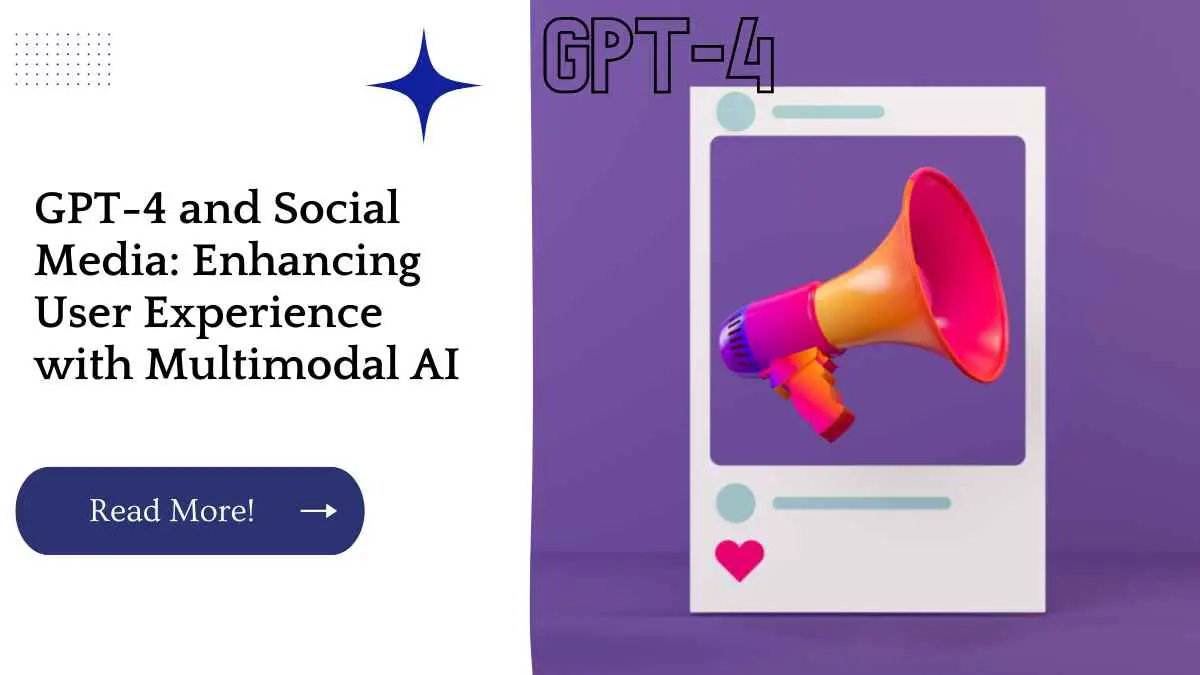Social media has become a ubiquitous part of modern-day life, with over 4.2 billion active users worldwide. It is a platform that has transformed the way people communicate, connect, and interact with each other.
As social media platforms continue to evolve, there is a growing need to make user experience more personalized and engaging. With the upcoming release of GPT-4, a multimodal AI model that integrates text, images, video, and sound, the social media landscape is set to undergo significant changes. In this blog post, we will explore the implications of GPT-4 on social media and how it can enhance user experience.
| Takeaways |
|---|
| GPT-4 is a multimodal AI language generation model with unprecedented performance. |
| GPT-4 has the potential to revolutionize several industries, including healthcare, e-commerce, education, and media. |
| GPT-4’s ability to understand and generate text, images, and sound can enhance user experience in social media and beyond. |
| The business implications of GPT-4 are significant and require careful consideration by companies looking to leverage its capabilities. |
| As GPT-4 is set to release in March 2023, it is important to stay updated on its developments and potential use cases. |
Personalized Content Recommendations
One of the primary ways GPT-4 can enhance user experience on social media is through personalized content recommendations. With its ability to integrate different modalities, GPT-4 can analyze a user’s browsing history, interests, and preferences to recommend relevant and engaging content.
For instance, if a user is interested in photography, GPT-4 can recommend social media pages, groups, or accounts that specialize in photography, suggest relevant hashtags, and provide personalized captions for their photos.
GPT-4 has been hailed as the next leap in AI language generation. As we explore its unmatched performance, we begin to see how it can revolutionize language processing. Discover more about GPT-4’s capabilities by reading our article on the next leap in AI language generation.
Multilingual Communication
GPT-4’s ability to work across multiple languages is a significant advantage for social media platforms that have a global user base. With its multilingual capabilities, GPT-4 can translate user-generated content, comments, and messages in real-time, making it easier for users to connect and communicate with each other across different languages.
For example, GPT-4 can translate a user’s post from English to Spanish and vice versa, enabling users to communicate effectively and connect with people from different parts of the world.
At Microsoft’s special event, we got a glimpse of GPT-4’s potential to revolutionize productivity. It has the power to enhance efficiency and automate tasks, saving time and resources. Learn more about GPT-4’s impact on productivity by checking out our article on reinventing productivity with AI.
Enhanced Image and Video Recognition
Another way GPT-4 can enhance user experience on social media is through its image and video recognition capabilities. With its advanced computer vision and natural language processing (NLP) capabilities, GPT-4 can analyze and tag images and videos, making it easier for users to search for and discover relevant content.
For example, GPT-4 can identify and tag objects, people, and locations in a user’s photos and videos, enabling users to search for and discover content related to their interests and preferences.
Improved Chatbots and Customer Service
Chatbots have become an integral part of social media platforms, enabling users to interact with businesses and brands easily.
With GPT-4’s advanced NLP capabilities, chatbots can become more sophisticated and offer a more personalized and engaging customer experience. GPT-4 can analyze user queries and responses, understand context, and provide relevant and accurate responses, making it easier for businesses to resolve customer queries and concerns.
GPT-4’s multimodal capabilities make it a powerful tool for data analysis and decision-making in environmental sustainability. By integrating data from different sources and modalities, GPT-4 can provide valuable insights into environmental issues. To learn more about how GPT-4 is enhancing sustainability efforts, read our article on enhancing data analysis and decision-making with multimodal AI.
Automated Content Moderation
Content moderation is an essential aspect of social media platforms, ensuring that users can communicate and interact in a safe and respectful environment. With its advanced AI capabilities, GPT-4 can automate content moderation, making it easier for social media platforms to detect and remove inappropriate and offensive content.
For example, GPT-4 can analyze user-generated content, comments, and messages, detect hate speech, cyberbullying, and other forms of abusive content, and take appropriate action to remove such content.
Improved Social Listening and Analytics
Social listening and analytics are critical components of social media marketing, enabling businesses to understand user behavior, preferences, and trends.
With GPT-4’s advanced AI capabilities, social listening and analytics can become more sophisticated and provide more accurate insights. GPT-4 can analyze user-generated content, comments, and messages, detect sentiment, understand context, and provide valuable insights into user behavior and preferences.
H2: Enhanced Augmented Reality and Filters
Augmented Reality (AR) and filters have become a popular feature on social media platforms, enabling users to enhance their photos and videos with digital effects and animations.
With its advanced computer vision and NLP capabilities, GPT-4 can enhance AR and filter features, making them more sophisticated and personalized. GPT-4 can analyze a user’s facial features, expressions, and background, and provide customized AR and filter effects, enabling users to create more engaging and personalized content.
E-commerce has become more personalized with the advent of GPT-4’s multimodal AI capabilities. It can analyze customer data from various sources to provide personalized shopping experiences. To learn more about how GPT-4 is changing the e-commerce landscape, check out our article on personalizing shopping experience with multimodal AI.
H2: Improved User Safety and Privacy
User safety and privacy are critical aspects of social media platforms, ensuring that user data and personal information are protected.
With GPT-4’s advanced AI capabilities, social media platforms can improve user safety and privacy by detecting and preventing cyber threats and data breaches. GPT-4 can analyze user behavior, detect anomalies and suspicious activities, and take appropriate action to prevent data breaches and cyber attacks.
H2: Automated Content Creation
Content creation is an essential aspect of social media marketing, enabling businesses to create engaging and relevant content for their audience.
With GPT-4’s advanced AI capabilities, content creation can become more automated and personalized.
GPT-4 can analyze user behavior, preferences, and interests, and generate personalized content that is relevant and engaging. For example, GPT-4 can generate personalized captions for photos, suggest topics for blog posts, and even create videos based on user preferences.
GPT-4’s multimodal capabilities can break barriers in media and entertainment, creating more engaging and immersive experiences. With its ability to generate text, images, and audio, GPT-4 can create compelling stories and characters. To learn more about how GPT-4 is transforming media and entertainment, read our article on breaking barriers with multimodal capabilities.
H2: Enhanced Influencer Marketing
Influencer marketing has become a popular strategy for businesses to reach their target audience on social media platforms. With GPT-4’s advanced AI capabilities, influencer marketing can become more sophisticated and personalized.
GPT-4 can analyze user behavior, preferences, and interests, and identify influencers that are relevant and engaging for a particular audience. For example, GPT-4 can analyze a user’s browsing history and suggest influencers that match their interests, enabling businesses to create more targeted and effective influencer campaigns.
Conclusion
In conclusion, GPT-4 has the potential to transform the social media landscape by enhancing user experience, improving safety and privacy, and enabling businesses to create more engaging and personalized content.
As social media platforms continue to evolve, GPT-4’s multimodal AI capabilities will become increasingly important in creating a more personalized, engaging, and safe social media experience for users.
Further Reading
Here are some additional resources for learning more about GPT-4:
Bernard Marr: GPT-4 is Here: Unleashing the Power of Multimodal AI and Redefining the Future of Communication – This article by Bernard Marr provides a comprehensive overview of GPT-4, including its capabilities and potential impact on various industries.
TechTarget: What is GPT-4? – This concise definition of GPT-4 on TechTarget provides a clear explanation of what GPT-4 is and how it works.
UX Design: What You Need to Know About GPT-4 and Its Business Implications – This article by UX Design Bootcamp provides a business-oriented perspective on GPT-4, exploring its potential impact on various industries.
FAQs
What is GPT-4 and how does it differ from GPT-3?
GPT-4 is the next iteration of OpenAI’s natural language processing model, following GPT-3. While specific details about GPT-4 are still largely unknown, it is expected to be even more advanced and powerful than its predecessor.
What are the potential applications of GPT-4?
GPT-4 has a wide range of potential applications, including language translation, content creation, customer service, and more. Its advanced capabilities in multimodal AI could also have significant implications for industries such as healthcare and education.
How does GPT-4 utilize multimodal AI?
GPT-4’s use of multimodal AI means that it can process and generate text, images, and other types of data simultaneously. This allows for more comprehensive and accurate outputs that can better reflect the nuances and complexities of real-world situations.
When will GPT-4 be released?
The exact release date for GPT-4 has not been announced, but it is expected to become available sometime in 2023.
What are the potential ethical concerns associated with GPT-4?
As with any advanced AI technology, there are potential ethical concerns surrounding GPT-4. These include issues related to bias, data privacy, and the potential impact on the job market. It will be important for researchers, developers, and policymakers to address these concerns as the technology continues to evolve.

Costantine Edward is a digital marketing expert, freelance writer, and entrepreneur who helps people attain financial freedom. I’ve been working in marketing since I was 18 years old and have managed to build a successful career doing what I love.
